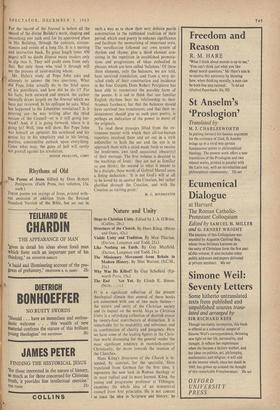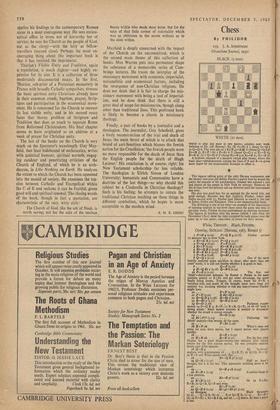Nature and Unity
Steps to Christian Unity. Edited by J. A. O'Brien. (Collins, 28s.) Like Nothing on Earth. By Guy Mayfield. (Darton, Longman and Todd, 21s.)
Why Was He Killed? By Guy Schofield. (Ep- worth Press, 15s.) The End Not Yet. By Ulrich E. Simon. -:i.) IT is a significant reflection of the present theological climate that several of these books are concerned with one of two main themes— the nature and unity of the Christian society and its impact on the world. Steps to Christian Unity is a refreshing collection of shortish essays by twenty-four contributors of distinction. It is remarkable for its readability and relevance, and its combination of charity and pungency. Here we have some of the leading figures in the Chris- tian world, discussing for the general reader the most significant tendency in twentieth-century Christianity, the move towards the reunion of the Churches.
Hans Kfing's Structures of the Church is in- tended, by contrast, for the specialist. Here translated from German for the first time, it represents the new look in Roman theology at its most radical and its most learned. Kfing, the young and progressive professor at Tiibingen, examines the whole idea of an ecumenical council from first principles. He is not content to trace the idea in Scripture and history; he
applies his findings to the contemporary Roman scene in a most courageous way. He sees ecclesi- astical office in terms not of hierarchy but of service; he sees the Church as the people of God, not as the clergy-with the laity as fellow- travellers (second class). Perhaps the most en- couraging thing about this important book is that it has received the imprimatur.
Thurian's Visible Unity and Tradition, again a translation, is much slighter-and highly ex- pensive for its size. It is a collection of three moderately disconnected essays. In the first, Thurian, sub-prior of a Protestant monastery in France with broadly Catholic sympathies, stresses the basic spiritual unity Christians already have in their common creeds, baptism, prayer, Scrip- tures and participation in the ecumenical move- ment. He is concerned for the Church to recover its lost visible unity, and in his second essay faces that thorny problem of Scripture and Tradition that does so much to separate Rome from Reformed Christendom. His final chapter seems to have originated as an address at a week of prayer for Christian unity.
The last of the books on the Church is very much on the Spectator's wavelength. Guy May- field, that least hidebound of ecclesiastics, writes with quizzical humour, spiritual warmth, engag- ing candour and penetrating criticism of the Church of England, of which he is an arch- deacon, in Like Nothing on Earth. He analyses the extent to which the Church has been squeezed into the mould of society. He examines the ten- sion between Catholic and Evangelical within the C of E and reckons it can be fruitful, given good will and spiritual renewal. The closing words of the book, though in fact a quotation, are characteristic of the racy, witty style :
The Church of God, like the ark of Noah, is worth saving; not for the sake of the unclean beasts within who made most noise, but for the sake of that little corner of rationality which was as oblivious to the storm without as to the stink within.
Mayfield is deeply concerned with the impact of the Church on the uncommitted, which is the second main theme of this collection of books. Max Warren puts into permanent shape the substance of a memorable series of Cam- bridge lectures. He traces the interplay of the missionary movement with economic, imperialist, nationalistic and ecumenical factors, including the resurgence of non-Christian religions. He does not think that it is fair to charge the mis- sionary movement with being a tool of imperial- ism, and he does think that there is still a great deal of scope for missionaries, though along other than traditional lines. This profound book is likely to become a classic in missionary theology.
Finally, a pair of books by a journalist and a theologian. The journalist, Guy Schofield, gives a lively reconstruction of the trial and death of Jesus, the main thrust of which is to attack that brand of anti-Semitism which blames the Jewish nation for the Crucifixion; 'the Jewish people were no more responsible for the death of Jesus than the English people for the death of Hugh Latimer.' His conclusion is, of course, right; his New Testament scholarship far less reliable. The theologian is Ulrich Simon of London University; humanists and Communists have a doctrine of the last things-so why should this subject be a Cinderella in Christian theology? Such is his feeling; he attempts to restate the traditional Christian teaching on these things in different symbolism, which he hopes is more acceptable to the modern mind.
E. M. B. GREEN







































 Previous page
Previous page